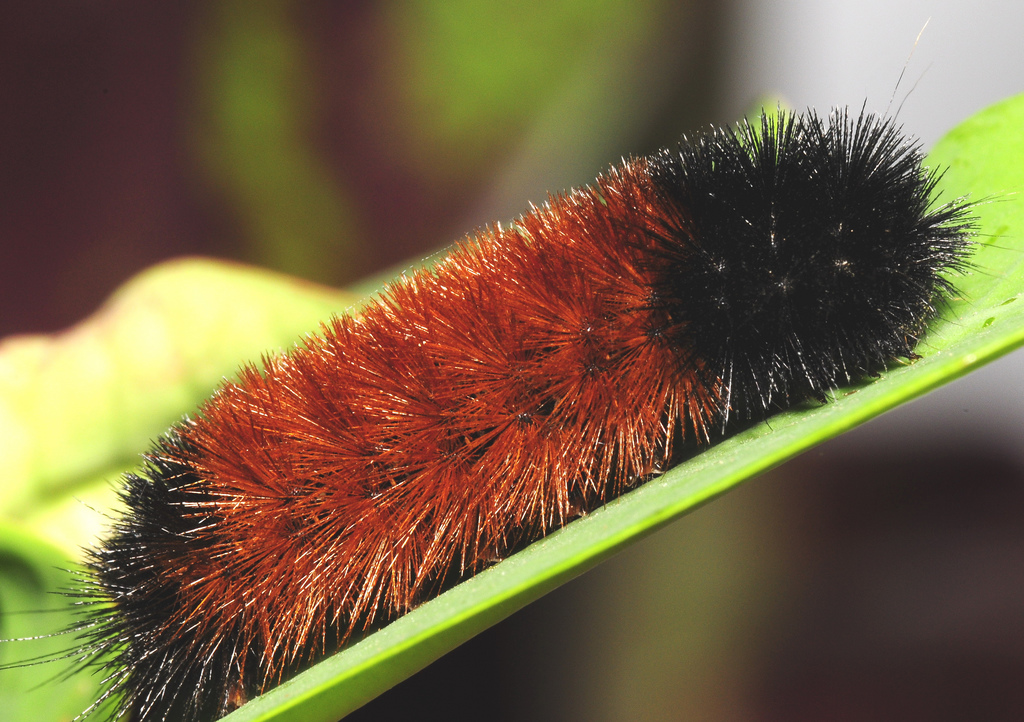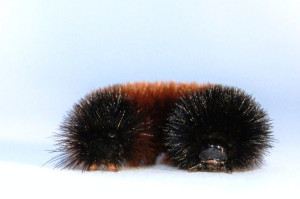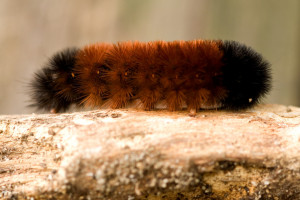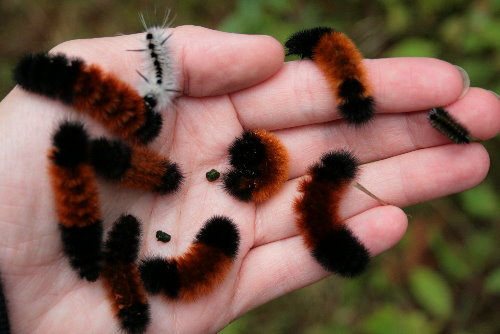What Does the Woolly Bear Caterpillar do in Winter?

How the Woolly Bear Caterpillar Survives the Cold
Have you ever wandered around a parking lot, sidewalk, or trail in the fall and seen a Wooly Bear caterpillar? They're the familiar fuzzy orange and black caterpillars that everyone dodges stepping on and that kids love to pick up and play with.

These fuzzy wee beasties are technically called the "Banded Woolly Bear" and they are the larval form of the Isabella Tiger Moth (Pyrrharctia isabella). The adult moth isn't very striking. It has golden-brown wings. They also have faint darker brown lines on their wings and the females have a pinkish-orange hind wing. The nice thing is that the caterpillar isn't a crop pest and mostly feeds on common deciduous forest trees such as elm, ash, low growing herbs, and other forest plants (they're not very picky and tend to sat away from gardens).
THE WOOLLY BEAR MYTH
Now most people have heard the myth that the woolly bear caterpillar can predict winter's length and intensity based on how much black is on them or how big the orange band is around their middle. This is really an old wives tale because as the caterpillar grows, during each molt (or shedding of its skin) the fuzzy black tips become less and less pronounced and the orange band grows. So, the caterpillar color barometer is really subjective based on which one you found and what molt phase it's in. Not very reliable if you ask me.

So, seeing all those fuzzy cute woolly bear caterpillars got me to thinking and wondering, if they don't predict winter, what exactly do they do to over-winter? Where do they go? How do they survive? Seeing as they can't crawl very far they have to have some strategy to make it through freezing conditions. After all they are found all the way from the Arctic to North America and Mexico.
OVERWINTERING MYSTERIES OF THE WOOLY BEAR
So what exactly does the woolly bear caterpillar do to stay alive in freezing conditions over the winter? Well, before I can answer that you need to know three important terms:
- Hibernation---this is a state of inactivity and when the metabolism of an animal slows down (low body temp, heart beat slows, slow breathing, and low metabolic rate).
- Diapause (similar to hibernation in mammals)---this is a pre-programmed genetically (and hormonally) controlled state of suspended or arrested development in an insect's life cycle. It can be caused by environmental cues and can occur at any life cycle stage of the insect. It usually occurs in anticipation of unfavorable seasonal conditions. During this time, much like mammalian hibernation, insects go into a slowed metabolic state. Diapause isn't easily reversible, the insect goes in and stays in until the genetics and environmental conditions signal the body to stop. Insects literally stop growing and metamorphosing too. This is a full stop process.
- Quiescence- is also insect specific, and is in direct response to environmental conditions. It is not pre-programmed and it's easily reversible when seasonal conditions become better. This can be a start and stop process, with periods of inactivity punctuated with periods of activity if it gets warm enough.

To break all that down:
-hibernation is for mammals,
-diapause and quiescence is for insects
-diapause is nearly the same thing as hibernation.
-diapause is genetically and hormonally caused
-quiescence is environmentally caused
-diapause can't be easily reversed but quiescence can be if environmental conditions change

For a long time scientists weren't sure if the woolly bear caterpillar used a strategy of diapause or quiescence to survive winter. Scientists from the University of Pennsylvania did some studies of different caterpillars collected in fall and winter and then compared their development and metabolic rates. They found that the woolly bear caterpillar goes into quiescence, hiding under leaf litter and literally going dormant until conditions change. They could wake easily if it got nice outside, unlike their diapausing cousins.
Researchers from Notre Dame did studies on how well the woolly bear caterpillar survived at different freezing and subfreezing temperatures. They found that the caterpillars are very resilient and cold-hardy, even their hemolymph (he-moe-lim-f), which is the insect equivalent of blood, can form ice crystals and they can still bounce back when conditions warm. They even from cryoprotectant (stuff that keeps their hemolymph from freezing and keeps the cold from causing cellular damage) if they are exposed to dehydration and cold suddenly.

Any way you shake it out the woolly bear caterpillar is pretty incredible. It may not be the winter indicator that everyone thinks about, but its ability to freeze and thaw and to go into quiescence in the winter is pretty amazing. It can literally freeze nearly to death and then thaw back out and be on its way. I kind of wish I could do this and just to into quiescence over the winter then get moving again when things get nice. Maybe someday this won't be science fiction if we learn from the woolly bear caterpillar.

